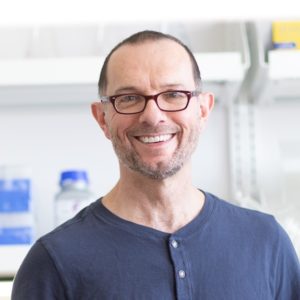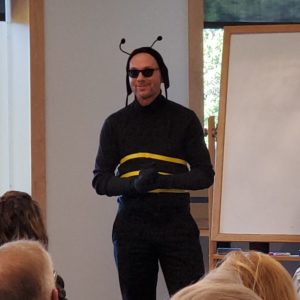by Buck Institute
April 22, 2019 . News
Bees are buzzing to the Buck, with the support of the Impact Circle!
Queen honey bees and worker bees are genetically identical, yet display extreme differences in many characteristics including size, behavior and, most remarkably, an 80-fold difference in lifespan! No one understands why this is so. Buck professor Simon Melov is keen to understand and exploit the mechanisms behind this dramatic lifespan difference, and the Buck Impact Circle recently awarded him $100,000 to use state-of-the-art genetic tools to tweak apart the distinctions.
Each year Impact Circle members are presented with a number of projects that focus on “dream big” research projects: collaborative efforts between Buck labs that have great promise, but are not far enough along to qualify for government funding. Faculty “pitch” their projects to the Impact Circle, and members vote on which project to support. A $5,000 donation gets you a vote and is the entry point for joining the Impact Circle.
 “Many thanks to the Impact Circle for supporting my project, which is unique in the field of research on aging,” said Melov, who has recruited a postdoc from Australia who specializes in bees to the Buck. “We think the mechanisms that allow the queen bee to live such an extremely long life will be conserved in higher organisms. Our hope is that we can move the findings into human cell culture and mice.”
“Many thanks to the Impact Circle for supporting my project, which is unique in the field of research on aging,” said Melov, who has recruited a postdoc from Australia who specializes in bees to the Buck. “We think the mechanisms that allow the queen bee to live such an extremely long life will be conserved in higher organisms. Our hope is that we can move the findings into human cell culture and mice.”
Bees as a model organism
Worker bees generally live five weeks while the queen lives five to eight years. During his presentation, Melov put that disparity in human terms. If the average lifespan of a worker bee is 75 human years, then the queen lives the equivalent of 18,000 to 30,000 years! “There are some suggestions that this difference might be due to alternative splicing of genes or epigenetic changes, which are potentially major drivers of aging in humans,” he explained. “Understanding the impact of how epigenetic and gene expression changes in the bee between worker versus queen will yield unique insights into aging that are not possible in any other model system.”
Both worker bees and queens develop similarly while transitioning through the egg, larval and pupal stages, but undergo drastically different development thereafter. Up to day three of development, female larvae are fed the same composition of larval food (known as royal jelly) and can become either workers or queens. The developmental trajectory that leads to a queen is a default program and appears to be reversible until day four of growth. The excess food given to queen larvae after day three has been reported to lead to distinct DNA methylation signatures during larval development. “The impact of diet on the life trajectory and lifespan of bees is beyond remarkable,” said Melov. “Now we have the genetic tools available to understand the process.”
More from members of the Impact Circle
In addition to helping fund Melov’s project, Impact Circle members Diane and Larry Rosenberger donated $45, 000 to fund a project in the Andersen and Campisi labs aimed at developing a new model to study Alzheimer’s disease. The research, which will happen in cultured human neurons, will focus on cellular senescence in neurons and the possibility that associated inflammatory factors drive pathology in early stages of the disease.
Alex and Robert Griswold donated $30,000 to buy specialized equipment to support a project in the lab of Buck Fellow Kai Zhou. That project is based on the fact that the survival and health of each cell in our body relies on the proper location of proteins. Zhou wants to see if correcting abnormal protein localization in cells could impede or reverse the effects of aging, thus potentially preventing age-related conditions such as Parkinson’s and Alzheimer’s disease .
The Griswold’s are longtime members of the Impact Circle and Bob is on the Buck Board of Trustees. “The best thing about being involved in this group is getting to know the people who are driving the research,” he said. “It’s exciting to be personally invested in the science and it’s rewarding to see the progress being made. And the comradery in the group is a big plus.”
The Impact Circle was established in 2014 and past projects have led to successful applications for federal funding and resulted in high impact publications. “The Impact Circle is one of the most exciting programs at the Buck,” says President and CEO Eric Verdin, MD. “As a scientist it’s very rewarding to develop personal relationships with donors and the seed money provided is a great boost to early-stage projects that have significant potential.”
Is there “Buck honey” in our future?
 Researchers who pitched projects to the Impact Circle left their usual power point presentations behind and were urged to use props during their presentations. Melov may have scored extra points by dressing up as a bee for his pitch; he also brought a jar of “Buck honey” to show the crowd. Melov says many hives will be needed to provide large sample sizes of queens for the project, so producing a Buck brand of honey is not out of the question. It also helps that Buck professor Judy Campisi, who will advise and collaborate on the project, raised honey bees in her backyard when she was a young researcher living in Boston.
Researchers who pitched projects to the Impact Circle left their usual power point presentations behind and were urged to use props during their presentations. Melov may have scored extra points by dressing up as a bee for his pitch; he also brought a jar of “Buck honey” to show the crowd. Melov says many hives will be needed to provide large sample sizes of queens for the project, so producing a Buck brand of honey is not out of the question. It also helps that Buck professor Judy Campisi, who will advise and collaborate on the project, raised honey bees in her backyard when she was a young researcher living in Boston.
Membership in the Impact Circle remains open. Those interested in getting involved should contact Lisa Palma, Director of Institutional Advancement at lpalma@buckinstitute.org. A meeting to update members will be scheduled for the fall.
Science is showing that while chronological aging is inevitable, biological aging is malleable. There's a part of it that you can fight, and we are getting closer and closer to winning that fight.
Eric Verdin, MD, Buck Institute President and CEO